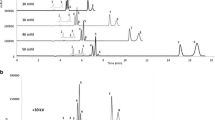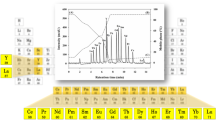Abstract
This paper examines two issues, the extensive pollution occurring in the Aries River, NW Romania, as a result of unchecked discharge of mining effluents into the river system, and the suitability of capillary electrophoresis (CE) as an analytical method for investigations into water chemistry. The results confirm the first objective by providing details on the pollution of the Aries River and its geochemical system and demonstrate the usefulness of CE. In its upper reaches, the river system is characterized by high contents of SO4 2– as a direct result of acid mine effluents and the oxidation of sulphide minerals on mine dumps as well as inflows from settling ponds. Although continuous dilution by natural branch waters and natural water-rock interaction reduces the pollution to some extend, the total level of SO4 2– remains above European averages. The waters of the Aries River, by comparison, contain contents of Cu2+ and Zn2+ up to 100 times higher than those of unpolluted river water.
Similar content being viewed by others
Author information
Authors and Affiliations
Additional information
Received: 1 November 1999 · Accepted: 3 April 2000
Rights and permissions
About this article
Cite this article
Forray, F., Hallbauer, D. A study of the pollution of the Aries River (Romania) using capillary electrophoresis as analytical technique. Environmental Geology 39, 1372–1384 (2000). https://doi.org/10.1007/s002540000168
Issue Date:
DOI: https://doi.org/10.1007/s002540000168




